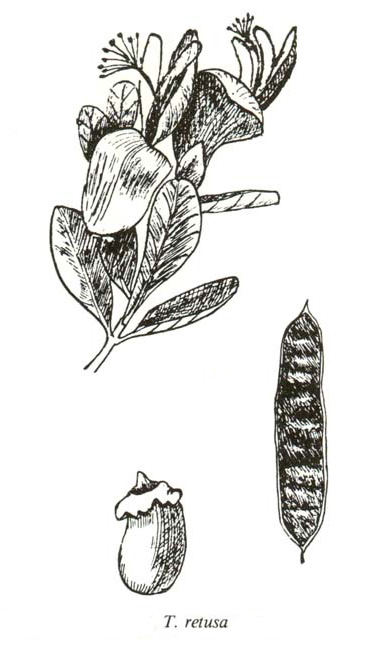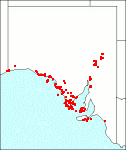Family: Fabaceae
Templetonia retusa
Citation:
R. Br. in W.T. Aiton, Hort. Kew. edn 2, 4:269 (1812).
Synonymy: Rafnia retusa Vent., Jard. Malm. 1:t. 53 (1804).
Common name: Cockies tongue, common (or red) templetonia, flame bush.
Description:
Shrub 1-3 m high, often somewhat glaucous; the branches angular, more or less sulcate, glabrous; leaves oblong-cuneate to obovate, 15-40 x 7-25 ram, flat, obtuse or notched, glaucous, leathery, the midrib ending in a minute mucro, veined on both surfaces; petiole articulate, thick, wrinkled, to 1 mm long, glabrous.
Flowers terminal and/or axillary, single to several, 30-40 mm long, on distinct to 10 mm long glabrous pedicels; bracts rounded, scale-like, c. 0.5 mm long, glabrous except for the ciliate margins; bracteoles distal on the pedicels, ovate, c. 1.5 mm long, glabrous except for the ciliate margins; pedicel thickened above the bracteoles and widening into the base of the glabrous calyx, which is 6-11 mm long with 4 short and very broad ciliate lobes; petals red or rarely yellow to white, all nearly equal, c. 30 mm long; standard ovate to obovate, 15-20 mm wide, obtuse; wings narrow-oblong, c. 5 mm wide; keel obtuse, usually darker at the tip; ovary stipitate, filiform, glabrous, tapering into a long slender style with a capitellate stigma, 10-15-ovulate.
Pod stipitate, linear-oblong, 40--80 x 1 0-16 mm, compressed, light-to dark-brown, with several transverse partitions and seeds; seed oblong-ovate, 6 x 3.5 mm, slightly compressed, light-brown, with a large oblique aril near the tip.

| Templetonia retusa twig, legume and seed.
|
Image source: fig 378b in Jessop J.P. & Toelken H.R. (Ed.) 1986. Flora of South Australia (4th edn).
|
Published illustration:
Costermarts (1981) Native trees and shrubs of southeastern Australia, p. 197.
|
|
Distribution:
|
S.Aust.: NU, FR, EP, NL, YP, KI, SE. W.Aust.
|
Conservation status:
native
Flowering time: July — Oct.
|

SA Distribution Map based
on current data relating to
specimens held in the
State Herbarium of South Australia
|
Biology:
No text
Author:
Not yet available
|

